Accommodation
The accommodation was substantially refitted in 2009-10, making changes to the layout of the saloon, galley and heads. This was in order to incorporate a pilot berth as a seaberth and an extra-long settee berth, as well as a purpose-built chart table, which was lacking in the original design. The galley and heads layouts were altered to improve the use of space.
From forward:
A large double-coaming forehatch accesses a seperate fo’c’sle store area, with cable locker forward, storage shelves either side and, beneath the sole, stowage for the second anchor cable and kedge anchor and cable.
Next aft is a large forecabin which comprises the owners’ sleeping accommodation. There is a double bunk to port with two drawers
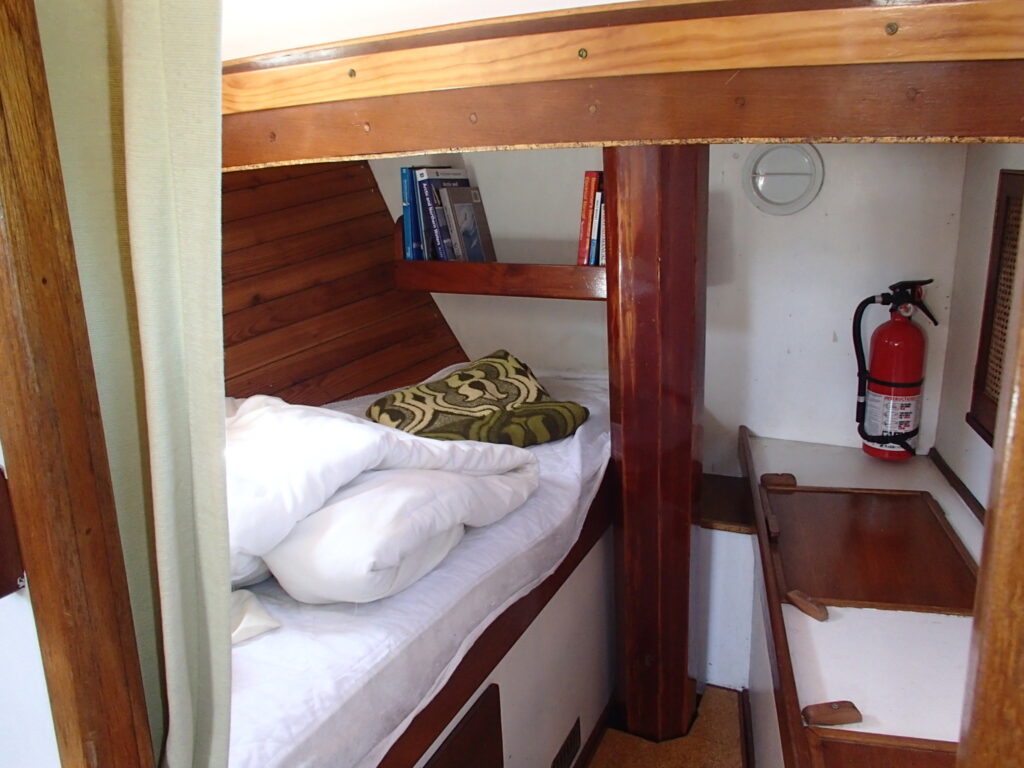
and two large storage bins under, as well as a little secret locker for valuables. To stbd is a bench with two further top-access lockers with varnished hinged lids, a small locker forward of the mainmast, and two clothes lockers, one fitted with shelving and the other with a hanging rail for your kilt, suits and uniforms. These are each fitted with attractive double doors with wicker fronts, allowing good ventilation. All lockers throughout are interconnected with ventilation holes and external vents to prevent damp and mould. The cabin sides in the forecabin and saloon are lined with varnished larch T&G panelling from the old pier at Ilfracombe, as is the deckhead. Other vertical surfaces and under-deck linings are painted off-white. On the fwd bulkhead over the foot of the bunk is a good-sized bookshelf which can take up to A4 sized books. Overhead is a double-coaming hatch with an inset smoked acrylic port.
Moving aft through a curtained doorway into the saloon and you have a 7-ft long settee berth to stbd, with two large locker behind hinged, upholstered seat-backs, and more lockers under the seat cushion. An attractive varnished pinrail fiddle keeps your belongings firmly on the shelf behind this settee. Here, at its forward end you will find the ship’s cut-glass whisky glasses in a custom rack, as well as further stowage for more glasses behind a solid fiddle. The aft portion has room for navigation equipment, flags, etc., but was custom fitted with a small fiddled stowage for some paperbacks, and space for a sextant box. Aft of this again is a deeper stowage for A4 size pilot books, manuals etc. lying outboard of the chart table (½ Admiralty size), next to the main switch panels. The chart table has a chart stowage slot under
accessed via a hinged panel, which can contain a large folio of charts. There is a further chart stowage in a drop-down box above the pilot berth to port. The settee berth extends beneath the chart table, and under this is the battery compartment. The battery switchboard is on the chart table support pillar.
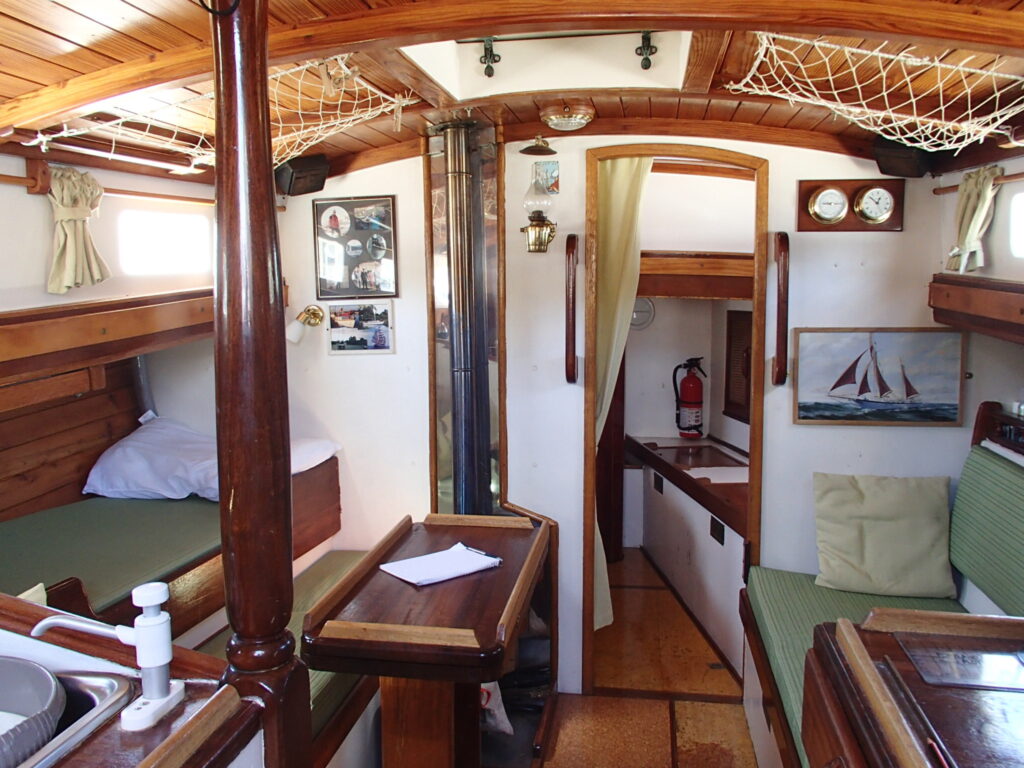
To port in the saloon is an L-shaped settee with the pilot berth outboard, with two small lockers under the head and foot. The middle section of the settee can be pulled out to form an occasional berth. Forward of the saloon table is the solid fuel heating stove, and the table has a fiddled top which folds out to stbd to form a large, unfiddled dining table for those cosy meals in port. A gimballed paraffin lamp graces the forward bulkhead amidships, whilst on the starboard side is an original oil painting of Meander under sail, painted by Bob Grimson, the boat’s multi-talented designer, builder and previous owner (see here). Above the dining area is another double-coaming deck hatch providing light and ventilation, and there is a dorade vent port and starboard, above the galley and chart table. These can be shut off in rough weather.
Further aft on the port side is the galley. This is not the pathetic postage stamp of an excuse for a galley which you find in a production boat. A full six feet in length, the u-shaped area has a gas cooker with a 2-burner hob, grill and oven. Unusually, this is mounted athwartships, as if it were fore-and-aft and gimballed it would need to be mounted very low to provide sufficient safe clearance under the side deck. Because Meander has exceptional form stability, and heels much less than most boats, this has never been a problem at sea, and you can cook a three-course meal as easily underway as in port. Sea-rails keep your pans from sliding on the hob. Inboard of the cooker, there is a narrow section of worktop which is ideal for your spoons and spatulas when cooking, and indeed if you lift the top you will find a six-inch deep locker ideal for stowing your utensils. Aft of the cooker is an open stowage area and easy-to-access gas tap. Outboard of the cooker is the large fridge (the compressor and evaporator plate were replaced in 2018), another hidden locker under the worktop, and outboard a stowage bin for pots and pans. The middle section has a substantial area of uninterrupted worktop, with crockery stowage outboard, and a cutlery drawer and deep food stowage locker under. The locker extends right out to the ship’s side and fwd to the bulkhead, and is ideally separated by using
stacking plastic boxes for stowing fresh veg, dry stores and tins. The forward section of the U houses the sink, with fresh water pumped by an efficient foot-pump, and a hand-pumped saltwater tap. Under the sink you will find space for cleaning gear, a lidded holder for bin-bags on the inside of the door, access to the water filter, the fresh water pump and the grey water pump. Under the cooker is a stowage area and access to the log impeller. This space can also be reached from a removable panel in the port cockpit locker to allow access to the fridge compressor. There is a second gimballed paraffin lamp above the forward part of the galley.
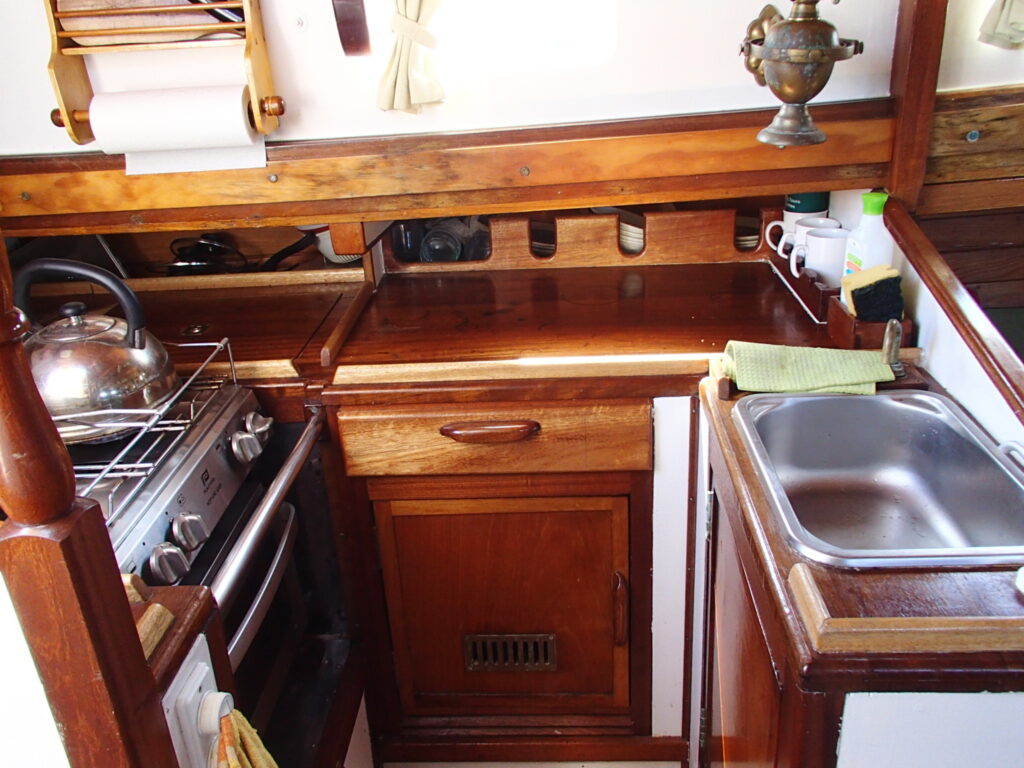
The main companionway is slightly offset to stbd, with the engine box below forming part of the companion steps. The lid is easily removed for routine checks, whilst the front can be removed by unscrewing a handful of screws for more complex maintenance. There is also a small access hatch to port from the locker under the cooker, and from the heads to stbd.
The heads compartment has a forward-facing Raritan sea toilet which pumps either to sea or to a holding tank. A locker behind the throne mostly houses the holding tank, waste hoses and
changeover valves, leaving enough space for some spare toilet rolls and toilet cleaner. Outboard of the throne is a wet locker which drains straight to the bilge, and also housing the first-aid kit, and forward of this is a ceramic corner basin and more stowage under the deck and outboard. There is a small rack for soap pumps and toothpaste etc and a mirror above the basin. Water is pumped to the faucet by way of a footpump. There is a drain in the sole so you can have a sponge bath without fear of flooding the compartment. There is a small hatch overhead, as well as a deck prism, making this the best lit compartment in the boat, and for ventilation in rough weather when the hatch is shut, a solar-powered extractor vent.
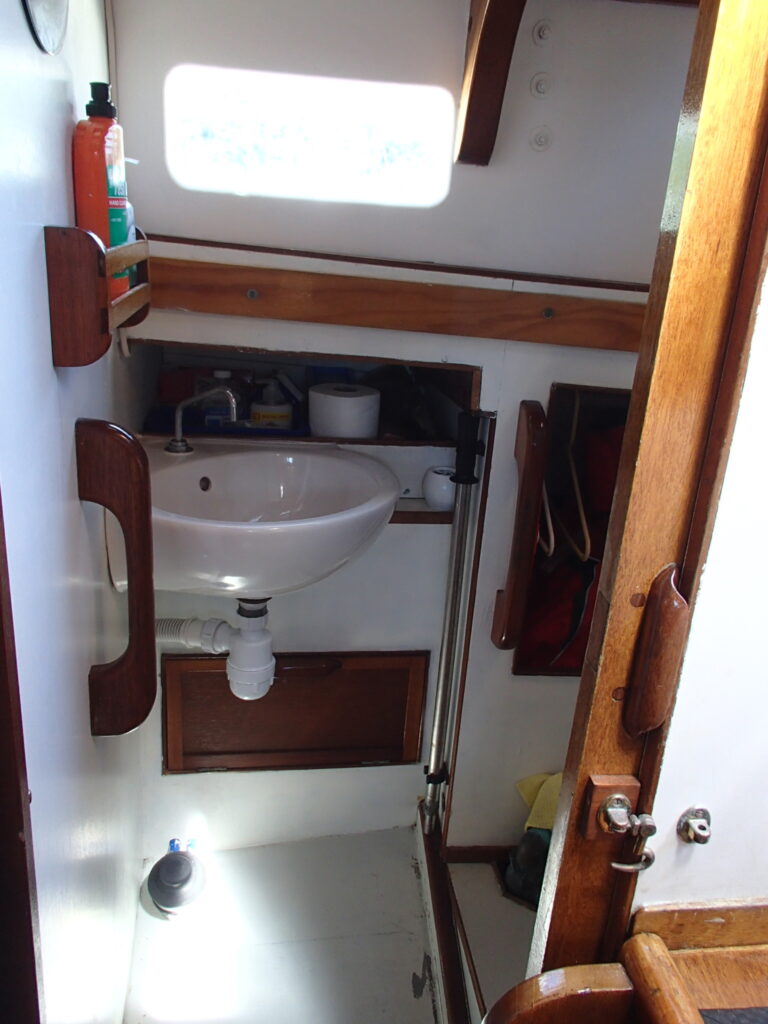
On deck
On exiting the companionway, you find yourself under a substantial sprayhood, with mainsheet (on a single-speed snubbing winch) and jib furling line (ditto) to port. Take a quick step around the mizzen mast and you are in the cockpit, with a deep locker either side
under the seats. To port there is a custom shelf for the liferaft, and removable panelling inboard gives access to the gearbox, shaft and stuffing box. To stbd the locker has a deep well outboard for fenders, whilst the fuel tank part-fills the inboard half, with a sounding tube fwd and further stowage on to of the tank.
The engine panel is to port and the Morse control to stbd of the helm position. There is a custom helmsman’s chair to stbd. The rudder stock head is accessible abaft the wheel and there is an emergency tiller stowed in the lazarette, which also houses the main steering gear. The lazarette hatch is semi-permanently secured from below, but there is an access panel in the bulkhead under the wheel as well. To port of the aft deck is the gas bottle stowage, large enough for two 4.5kg butane cylinders. Across the pushpit is a wooden slatted seat which is a good watchkeeping position in most conditions. From here you have a good view ahead and easy access to the Monitor self-steering, which can also be coupled to a Raymarine tiller pilot for motoring in calm conditions.
Moving forward along the side decks, you will see the Highfield levers to port and starboard of the cockpit for the running backstays. These stays are made from dyneema rope in order to eliminate chafe on the mainsail.
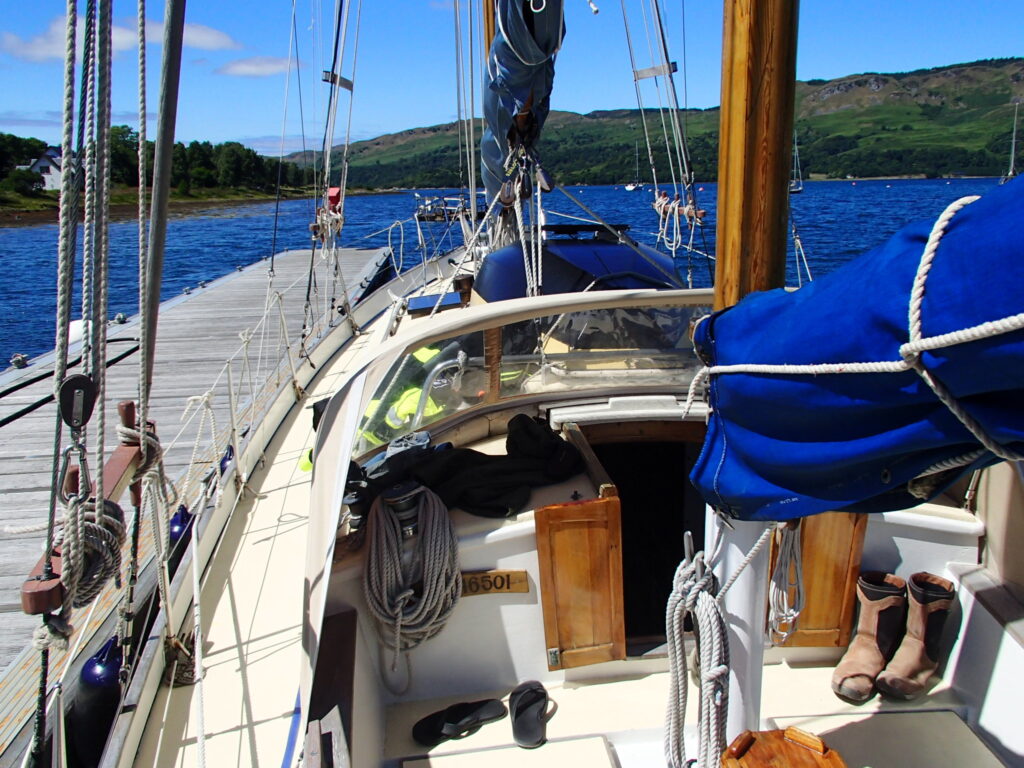
There are chocks to fit a Yachting Monthly Y-Emma plywood pram dinghy on the coachroof. Unfortunately my dinghy is not to be included in the sale, but I do know where there might be another for sale, so please ask if you are interested. There are substantial grabrails along the full length of the coachroof.
At the foot of the mainmast is a substantial stainless steel fiferail for main, staysail, jib and topsail halyards, with more belaying pins on sheerpoles at the main shrouds.
Forward you have the large accesshatch to the fo’c’sle store, which is large enough for all sorts of bosunry and a few extra sails. The windlass is bolted through the inboard end of the bowsprit, which itself abuts a hefty sampson post. This, together with a large cleat, the windlass itself and bronze panama fairleads in the bulwarks, makes for very strong mooring arrangements. The manual windlass is substantial and
powerful. The main anchor can be stowed securely in the roller, bowsed up to the bowsprit, to avoid damage to the hull or bowsprit, or simply hooked on the bobstay in the coasting tradition. Guardrails surround the entire deck with a stainless pushpit fwd. The bowsprit is a traditional pole bowsprit and makes no concessions to ease of access. In the rare event that you require access at sea, a harness comes highly recommended! It is tipped with a nice hefty cranse iron to ease berthing amongst fibreglass yachts.
